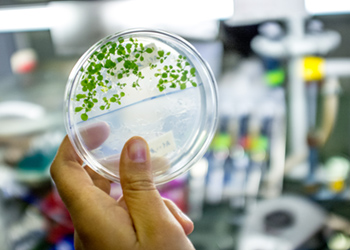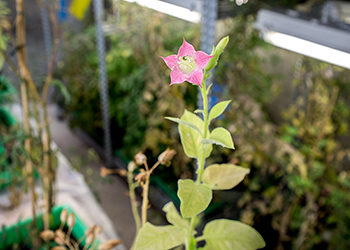
Plant Genomics
Jörg Dieter Becker
The Plant genomics research group is interested in mechanisms controlling sexual reproduction and early embryogenesis.
They are primarily studying these processes in two plant model species:
The angiosperm Arabidopsis thaliana and the bryophyte Physcomitrella patens.
In angiosperms, a pollen tube delivers two sperm cells to the embryo sac to ensure fertilization of the egg and central cell, respectively. In bryophytes on the other hand a free-swimming, flagellated sperm fertilizes an egg cell.
A particular focus of their work lies on (epi)genetic mechanisms acting during male gametogenesis.
In Arabidopsis, development of the male gametophyte involves reprogramming events at both genetic and epigenetic level, leading to a very distinct transcriptome in male gametes, accompanied by alterations in their epigenetic landscape. The latter in particular has far-reaching implications for transposon silencing, transgenerational inheritance and imprinting of maternally expressed genes. Researchers are analysing how these changes come about and what are their potential consequences after fertilization.
Bryophytes were among the first colonizers of land and they occupy an important phylogenetic position for the elucidation of the development of seed plants, due to their separation from the vascular plant lineage about 450 Ma ago.
The moss Physcomitrella patens serves as our model to study the evolution of (epi)genetic mechanisms governing male gametogenesis. This is based on the expectation that some key components have been conserved during the evolution of plants on land, e.g. irrespective of male gametes being free swimming in extant early land plants or being delivered passively within a pollen tube in angiosperms.
In the long run their projects contribute to a better understanding of sexual reproduction in higher plants, a knowledge gain, crucial to overcome fertilization barriers and enhance crop productivity, with the ultimate goal to increase the capacity to generate sufficient food, animal feed and energy.
Projects
Here, a particular focus is on the role of LOTUS-domain proteins during these stages of development.
The project “Evolution of Sexual Reproduction in Plants” (EVOREPRO – www.evorepro.org) will deliver the first comprehensive view of the molecular evolution of plant sexual reproduction and will provide insights into the origins of double fertilization in plants.
Together with six cooperation partners from Europe and the US, our aim is to generate an EVOREPRO database comprising RNA-Seq data across eight plant species with a focus on reproductive tissues. These data are used to generate co-expression networks, in order to uncover new conserved sets of genes relevant for gamete development in land plants.
Our team is acting as project coordinator and has generated transcriptome data of Arabidopsis and the early divergent land plant Physcomitrella patens for the database. Beyond this we are unravelling changes in the transcriptome and epitome of Physcomitrella to gain insight into the extent and functionality of epigenetic mechanisms acting specifically during gametogenesis and sporogenesis.
Double fertilization is a hallmark of angiosperm development.
Mature pollen consists of the vegetative cell and the two plasma membrane-bound sperm cells enclosed within its cytoplasm. In contact with a receptive stigma, pollen germinates producing a pollen tube, which will grow through the pistil until it reaches the embryo sac.
Here the two sperm cells will be released, one fertilizing the egg cell and the other the central cell. Preferential fertilization, in which each sperm cell is predestined to fuse with either the egg cell or the central cell, can be found in a limited number of angiosperms with dimorphic sperm cells.
Whether preferential fertilization also exists in angiosperms with isomorphic sperm cells (e.g. Arabidopsis thaliana) has been a long-standing question. The current consensus based on mutant analyses and semi in vivo experiments is that no such preferential fertilization exists in Arabidopsis.
In this project, we are addressing the question if gene expression levels differ in isomorphic sperm cell pairs and if such differences could lead to preferential fertilization.
The eukaryotic cilium or flagellum is present in all branches of the eukaryotic tree of life and is critical for cell motility and sensing.
It always consists of a microtubule axoneme, surrounded by a membrane that extends from a modified centriole, called basal body. In some species, centrioles are also part of the centrosomes, which nucleate microtubules and participate in cell division.
While plant vegetative cells are devoid of centrioles, early land plants (such as bryophytes) form motile sperm cells during spermatogenesis. In this case, centrioles form de novo, providing an excellent system to investigate cilia evolution and de novo centriole assembly.
Focussing on the sperm cells’ centrioles of the model bryophyte Physcomitrella patens, we aim to describe spermatogenesis and de novo centriole formation at an ultrastructural level.
In parallel we are studying the regulation of motility and chemotaxis in mature sperm cells in this extant moss. While in animals sperm motility has been largely studied, in plants the mechanisms and molecular entities are still unknown.
We are using a transcriptome-guided approach to identify candidate genes with potential functions in sperm motility and chemotaxis signalling pathways.
Publications
- Sónia Gomes Pereira, Ana Laura Sousa, Catarina Nabais, Tiago Paixão, Alexander J.Holmes, Martin Schorb, Gohta Goshima, Erin M. Tranfield, Jörg D. Becker, Mónica Bettencourt-Dias (2021) The 3D architecture and molecular foundations of de novo centriole assembly via bicentrioles. Current Biology
- Julca, I., Ferrari, C., Flores-Tornero, M. et al. (2021) Comparative transcriptomic analysis reveals conserved programmes underpinning organogenesis and reproduction in land plants. Nat. Plants
- Ortiz-Ramírez, C., Michard, E., Simon, A.A., Damineli, D.S.C., Hernández-Coronado, M., Becker, J.D. , Feijó, J.A. (2017) GLUTAMATE RECEPTOR-LIKE channels are essential for chemotaxis and reproduction in mosses.. Nature 549:91–95
- Ortiz-Ramírez, C.*, Hernández-Coronado, M.*, Thamm, A., Catarino, B., Wang, M., Dolan, L., Feijó, J.A., Becker, J.D. (2016) A transcriptome atlas of Physcomitrella patens provides insights into the evolution and development of land plants.. Mol Plant. 9:205-220
- Pereira, P.A., Navarro-Costa, P., Martinho, R.G., Becker, J.D. (2014) Evolutionarily-conserved mechanisms of male germline development in flowering plants and animals.. Biochem Soc Trans. 42:377-382
- Borges, F., Gardner, R., Lopes, T., Calarco, J.P., Boavida, L.C., Slotkin, R.K., Martienssen, R.A., Becker, J.D. (2012) FACS-based purification of Arabidopsis microspores, sperm cells and vegetative nuclei.. Plant Methods. 8:44
- Calarco, J.P., Borges, F., Donoghue, M.T., Van Ex, F., Jullien, P.E., Lopes, T., Gardner, R., Berger, F., Feijó, J.A., Becker, J.D. , Martienssen, R.A. (2012) Reprogramming of DNA methylation in pollen guides epigenetic inheritance via small RNA.. Cell 151:194-205
- Borges, F., Pereira, P.A., Slotkin, R.K., Martienssen, R.A., Becker, J.D. (2011) MicroRNA activity in the Arabidopsis male germline.. J Exp Bot. 62:1611–1620
- Slotkin, R.K., Vaughn, M., Borges, F., Tanurdžić, M., Becker, J.D. , Feijó, J.A., Martienssen, R.A. (2009) Epigenetic reprogramming and small RNA silencing of transposable elements in pollen.. Cell 136:461–472
- Borges, F., Gomes, G., Gardner, R., Moreno, N., McCormick, S., Feijó, J.A., Becker, J.D. (2008) Comparative transcriptomics of Arabidopsis thaliana sperm cells.. Plant Physiol. 148:1168-1181
- Pina, C., Pinto, F., Feijó, J.A., Becker, J.D. (2005) Gene family analysis of the Arabidopsis pollen transcriptome reveals biological implications for cell growth, division control and gene expression regulation.. Plant Physiol. 138:744-756
- Becker, J.D. , Boavida, L.C., Carneiro, J., Haury, M., Feijó, J.A. (2003) Transcriptional profiling of Arabidopsis tissues reveals the unique characteristics of the pollen transcriptome.. Plant Physiol. 133:713-725


